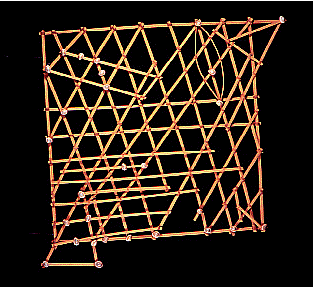I was arguing today (well, bickering actually) about whether a Mac or Wintel PC was the right tool for a particular job, and I was suddenly reminded of an extremely eccentric art history lecture I attended almost 30 years ago.

When the lecture began, a slide very similar to this photograph was projected on the screen at the front of the hall. The lecturer asked the students if they could guess the purpose of this object, and where it originated. We could see the small seashells at some of the intersections of the sticks, eventually someone guessed correctly that it originated in the Pacific Islands near Asia. But nobody even came close to identifying the object's purpose.
Eventually the lecturer revealed that the object is a navigational map of the ocean, a Micronesian Stick Chart. The sticks represent ocean currents and the seashells represent islands, but the map's distances are not accurate on a geographic scale, they are scaled to the time it took to travel the ocean currents between the islands. Suddenly it all made sense. But then the lecturer veered off into incomprehensible, uncharted territory for us poor art students.
The lecturer asserted this object was the embodiment of "technomorphia." The object was made from the conveniently available local materials, sticks and shells, and was better suited to being carried in small seafaring boats than paper maps. He pointed out that the Micronesians had not yet learned to make paper at the time these maps were invented, but even after they learned the papermaking secret, they still preferred the Stick Charts over paper maps. Sticks and shells don't get soggy in seawater, and can be mended easily. He rambled on about technomorphic aspects of this artform, and how it developed in the cultural context of Micronesia. I didn't understand much of it, and neither did anyone else.
This particular lecturer was notorious for using incomprehensible jargon, sometimes he even made stuff up as he went along, so I always took notes and asked him for definitions after the lecture was over. I challenged him on technomorphia, and asked him to explain further. He talked about how the tools and materials available determined the forms the artwork would take. He talked at length about how technomorphia affected each separate media (i.e. printmaking, painting, photography) and how each media's expressive possibilities were achieved despite the limitations of that media. I responded, "oh, you mean, when you only have a hammer, every job looks like a nail."

When the lecture began, a slide very similar to this photograph was projected on the screen at the front of the hall. The lecturer asked the students if they could guess the purpose of this object, and where it originated. We could see the small seashells at some of the intersections of the sticks, eventually someone guessed correctly that it originated in the Pacific Islands near Asia. But nobody even came close to identifying the object's purpose.
Eventually the lecturer revealed that the object is a navigational map of the ocean, a Micronesian Stick Chart. The sticks represent ocean currents and the seashells represent islands, but the map's distances are not accurate on a geographic scale, they are scaled to the time it took to travel the ocean currents between the islands. Suddenly it all made sense. But then the lecturer veered off into incomprehensible, uncharted territory for us poor art students.
The lecturer asserted this object was the embodiment of "technomorphia." The object was made from the conveniently available local materials, sticks and shells, and was better suited to being carried in small seafaring boats than paper maps. He pointed out that the Micronesians had not yet learned to make paper at the time these maps were invented, but even after they learned the papermaking secret, they still preferred the Stick Charts over paper maps. Sticks and shells don't get soggy in seawater, and can be mended easily. He rambled on about technomorphic aspects of this artform, and how it developed in the cultural context of Micronesia. I didn't understand much of it, and neither did anyone else.
This particular lecturer was notorious for using incomprehensible jargon, sometimes he even made stuff up as he went along, so I always took notes and asked him for definitions after the lecture was over. I challenged him on technomorphia, and asked him to explain further. He talked about how the tools and materials available determined the forms the artwork would take. He talked at length about how technomorphia affected each separate media (i.e. printmaking, painting, photography) and how each media's expressive possibilities were achieved despite the limitations of that media. I responded, "oh, you mean, when you only have a hammer, every job looks like a nail."
Leave a comment